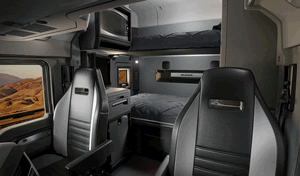Long Haul Connectors
Trucking industry trends all point to a solid market for high-reliability connectors.
Nearly every trend in commercial trucking is fueling increased demand for connectors. The move to hybrid and electric vehicles isn’t limited to automotive. Heavy, long-haul trucks are moving in this direction too, creating a need for high-power connectors. The expanding role of LEDs and electronic functions in cabs requires more connections. Additionally, the long-term focus on autonomous vehicles will require extensive sensor suites and extremely high-speed processing.
Many of the trends in trucks follow those in passenger cars. However, trucks sometimes lead the way. Autonomous trucks are already in use in some mining sites. They may rival usage when on-highway autonomous vehicles finally hit the road, since a driver shortage and a push to improve efficiency may prompt some fleet owners to utilize the technology. However, many of the technologies needed for driverless trucks are coming from autos.

DAF Trucks is devising techniques that let tractors determine what size load they’re hauling.
“Trucks were the pioneers with early cruise control and camera systems, but cars have pulled ahead, so trucks will mostly use off-the-shelf automotive sensors,” said John Cooper, director of vehicle integration and driving assistance at IAV Automotive Engineering. “The sensor arrangements will be a lot different. Getting an all-around vehicle view with sensors is really a difficult challenge when you’re dealing with detachable trailers.”
While the sensors and processing modules will be similar, the implementations will be quite different. When tractors pull trailers, controls and sensors must account for the size of the trailer or trailers, while also adjusting for the loads being hauled. It will be challenging to combine sensors to provide a 360-degree view of the driving environment, regardless of the size of trailers in tow.
“Lane-keeping systems need to adjust to what’s in the trailers, whether they’re half full or full, their length, and whether there’s liquid in the container,” said DAF Trucks’ Jack Martens. “We’re trying not to add technology to the trailer. If the driver can sense the difference, the system on the tractor should be able to sense it too.”
Connectors and Sensors Come Along for the Ride
Autonomous vehicles will create a solid market for connectors. A number of different sensor technologies are being deployed in the next generation of trucks, and they all must handle rigorous requirements for high speeds, as well as be vibration- and shock-proof, and provide extremely high reliability. It’s possible that a number of tiny, inexpensive sensors will be connected to vehicle networks.
“The sensor set on the tractor will probably be a combination of four or five cameras and at least three radars,” Cooper said. “LIDAR has a place too. The number of sensors may go fairly high, depending on how successful sensor manufacturers are at creating small, inexpensive sensors. There are developers working on ultra-small radars, about an inch square, that you can plaster around the periphery of the vehicle.”
“Systems can’t miss a critical object or report a critical object that’s not really there,” said Karl-Heinz Glander, chief engineering manager for ZF’s Automated Driving Team. “You need a mixture of technologies to avoid these issues. Single-sensor solutions are not possible.”
Another trucking industry trend may create a market for connectors that can handle lots of power. Mid-sized trucks are beginning to adopt fully electrified powertrains. Batteries probably won’t power large trucks that carry 20-ton or larger payloads, but there’s plenty of work in smaller vehicles, especially those that do a lot of start-stop driving.
Daimler Trucks’ Mitsubishi FUSO Truck and Bus Corp. launched an all-electric light-duty truck, the eCanter, in September and said UPS is already a commercial partner. UPS has a number of hybrid tests, but this marks one of its first commercial vehicle implementations.

Mitsubishi unveiled an all-electric truck that has already caught the eye of UPS.
Electrified vehicle development programs are exploding. Cummins just demonstrated a fully electric concept truck. Volvo Construction Equipment partnered with Waste Management to test an electric hybrid wheel loader. Navistar’s Catalist concept truck uses rooftop solar panels to charge its hybrid battery pack.
While connector suppliers wait to see how widespread the market for autonomous and electrified vehicles becomes, other trends should foster expanded growth. As in passenger cars, electronic features and functions are becoming a key market differentiator.

Mack’s Anthem features an interior that makes extensive use of LEDs.
In September 2017, Mack truck President Dennis Slagle unveiled the Anthem, calling it “one of the most significant new trucks in Mack’s 117-year history.” He touted cab features that include a number of LEDs and an optional infotainment seven-inch touchscreen display that gives drivers safe access to Apple CarPlay, satellite radio, weather band radio, and TomTom truck navigation. Additional displays were also added to help drivers improve efficiency.
The life of a trucker will continue to be demanding, with long days and long absences from home — not to mention the stresses that come with navigating a huge vehicle through increasingly crowded and challenging road conditions. But with the help of advanced interconnects, the driving experience is set to become safer, more comfortable, and more connected than ever.
- State of the Industry: 2022-2023 Connector Sales - April 16, 2024
- Amphenol is On a Roll - April 2, 2024
- Nicomatic Proves That Two Heads are Better Than One - March 26, 2024





